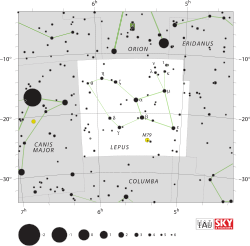Beta Leporis

| |
| Observation data Epoch J2000.0 Equinox J2000.0 (ICRS) | |
|---|---|
| Constellation | Lepus |
| Right ascension | 05h 28m 14.72316s[1] |
| Declination | −20° 45′ 33.9878″[1] |
| Apparent magnitude (V) | 2.84[2] |
| Characteristics | |
| Spectral type | G5 II[3] |
| U−B color index | +0.47[2] |
| B−V color index | +0.82[2] |
| R−I color index | +0.44[4] |
| Astrometry | |
| Radial velocity (Rv) | −13.6 ± 0.9[5] km/s |
| Proper motion (μ) | RA: −5.02[1] mas/yr Dec.: −85.92[1] mas/yr |
| Parallax (π) | 20.34 ± 0.18[1] mas |
| Distance | 160 ± 1 ly (49.2 ± 0.4 pc) |
| Details | |
| Mass | 3.5 ± 0.1[6] M☉ |
| Radius | 16[7] R☉ |
| Luminosity | 171[8] L☉ |
| Surface gravity (log g) | 2.60 ± 0.03[6] cgs |
| Temperature | 5,450 ± 100[6] K |
| Metallicity [Fe/H] | +0.05[9] dex |
| Rotational velocity (v sin i) | 11[10] km/s |
| Age | 240[6] Myr |
| Other designations | |
| Database references | |
| SIMBAD | data |
Beta Leporis (Beta Lep, β Leporis, β Lep) is the second brightest star in the constellation of Lepus.[7] It is also known as Nihal,"quenching their thirst". The occasional spelling Nibal appears to be due to a misreading.[11]
Based on parallax measurements from the Hipparcos astrometry satellite,[12] this star is located about 160 light-years (49 parsecs) from the Earth. It has an apparent visual magnitude of 2.84 and a stellar classification of G5 II. The mass of this star is 3.5 times the mass of the Sun and it is about 240 million years old,[6] which is sufficient time for a star this massive to consume the hydrogen at its core and evolve away from the main sequence, becoming a G-type bright giant.[3]
This is a double star system and may be a binary. Using adaptive optics on the AEOS telescope at Haleakala Observatory, the pair was found to be separated by an angle of 2.58 arcseconds at a position angle of 1.4°.[13] Component B has been observed to fluctuate in brightness and is catalogued as suspected variable star NSV 2008. [14]
References
- ↑ 1.0 1.1 1.2 1.3 1.4 van Leeuwen, F. (November 2007). "Validation of the new Hipparcos reduction". Astronomy and Astrophysics 474 (2): 653–664. arXiv:0708.1752. Bibcode:2007A&A...474..653V. doi:10.1051/0004-6361:20078357.
- ↑ 2.0 2.1 2.2 Johnson, H. L. et al. (1966). "UBVRIJKL photometry of the bright stars". Communications of the Lunar and Planetary Laboratory 4 (99). Bibcode:1966CoLPL...4...99J.
- ↑ 3.0 3.1 3.2 "CCDM J05283-2046AB -- Double or multiple star", SIMBAD (Centre de Données astronomiques de Strasbourg), retrieved 2011-12-27
- ↑ HR 1829, database entry, The Bright Star Catalogue, 5th Revised Ed. (Preliminary Version), D. Hoffleit and W. H. Warren, Jr., CDS ID V/50. Accessed on line November 18, 2008.
- ↑ Evans, D. S., "The Revision of the General Catalogue of Radial Velocities", in Batten, Alan Henry; Heard, John Frederick, Determination of Radial Velocities and their Applications, Proceedings from IAU Symposium no. 30 held at the University of Toronto 20-24 June, 1966, Academic Press, London, p. 57, Bibcode:1967IAUS...30...57E
- ↑ 6.0 6.1 6.2 6.3 6.4 Lyubimkov, Leonid S. et al. (February 2010), "Accurate fundamental parameters for A-, F- and G-type Supergiants in the solar neighbourhood", Monthly Notices of the Royal Astronomical Society 402 (2): 1369–1379, arXiv:0911.1335, Bibcode:2010MNRAS.402.1369L, doi:10.1111/j.1365-2966.2009.15979.x
- ↑ 7.0 7.1 Kaler, James B., "Nihal", Stars, retrieved 2008-11-18
- ↑ Mallik, Sushma V. (December 1999), "Lithium abundance and mass", Astronomy and Astrophysics 352: 495–507, Bibcode:1999A&A...352..495M
- ↑ Luck, R. Earle; Wepfer, Gordon G. (November 1995), "Chemical Abundances for F and G Luminosity Class II Stars", Astronomical Journal 110: 2425, Bibcode:1995AJ....110.2425L, doi:10.1086/117702
- ↑ Bernacca, P. L.; Perinotto, M. (1970). "A catalogue of stellar rotational velocities". Contributi Osservatorio Astronomico di Padova in Asiago 239 (1). Bibcode:1970CoAsi.239....1B.
- ↑ Allen, Richard Hinckley (1899), Star-names and Their Meanings, New York: G. E. Steichert, pp. 265, 269
- ↑ Perryman, Michael (2010), The Making of History's Greatest Star Map, Heidelberg: Springer-Verlag, doi:10.1007/978-3-642-11602-5
- ↑ Roberts, Lewis C., Jr. (May 2011), "Astrometric and photometric measurements of binary stars with adaptive optics: observations from 2002", Monthly Notices of the Royal Astronomical Society 413 (2): 1200–1205, arXiv:1012.3383, Bibcode:2011MNRAS.413.1200R, doi:10.1111/j.1365-2966.2011.18205.x
- ↑ "NSV 2008, database entry", New Catalogue of Suspected Variable Stars, the improved version (Moscow, Russia.: Sternberg Astronomical Institute), retrieved 2008-11-18
| ||||||||||||||||||||||||||||||||||